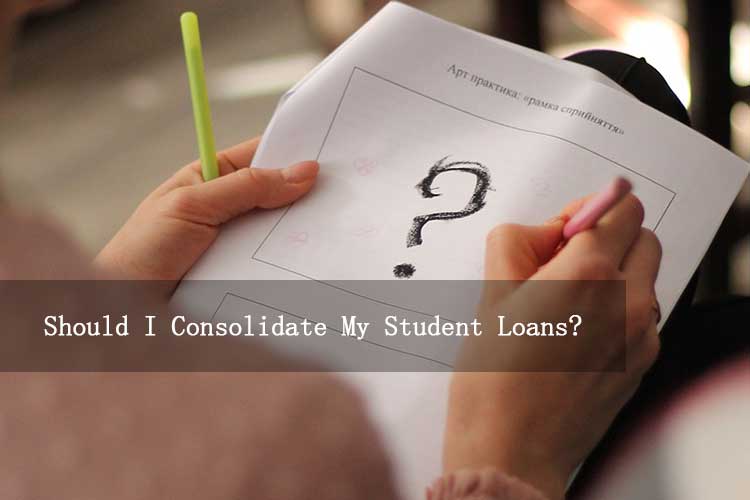
Managing multiple student loans can feel overwhelming.Should I Consolidate My Student Loans? If you’re tired of juggling different payments, consolidation might seem like a great solution. But is it the right move for everyone? The answer depends on your financial situation and future goals. This guide explains how student loan consolidation works, its advantages and disadvantages, and when it makes sense to consolidate your loans.
By the end of this article, you’ll have a clear idea of whether student loan consolidation is the right choice for you.
What Is Student Loan Consolidation?
Student loan consolidation means combining multiple loans into one new loan with a single fixed interest rate. The idea is to simplify payments—one payment each month instead of several—and reduce the chance of missing due dates.
There are two main types of consolidation.
- Federal Loan Consolidation: Available through the U.S. Department of Education, this applies only to federal student loans.
- Private Loan Consolidation (Refinancing): Offered by private lenders, such as banks and credit unions, and can combine both federal and private loans.
Benefits of Consolidating Your Student Loans
1. Simplified Payments
Having multiple student loans with different due dates can be stressful. Consolidation lets you replace several loans with one, giving you just one payment to manage each month. This simplicity helps you stay on track and avoid missed payments that could hurt your credit score.
2. Lower Monthly Payments
Consolidating federal loans often allows borrowers to extend their repayment period—from 10 years to 20 or even 30 years. This extension can reduce your monthly payment, which can be a big help if you’re working part-time, just starting your career, or dealing with other financial responsibilities. However, keep in mind that paying for a longer time will increase the total interest you owe.
3. Fixed Interest Rate
With federal loan consolidation, your new loan comes with a fixed interest rate. The new rate will be the weighted average of the interest rates on your original loans, rounded up slightly. If interest rates rise in the future, this fixed rate protects you from increases.
4. Access to Income-Driven Repayment Plans
Some repayment plans, like Income-Based Repayment (IBR) and Pay As You Earn (PAYE), are only available for federal Direct Loans. If you consolidate older federal loans—like Perkins or FFEL loans—you can unlock these income-driven repayment options.
5. Eligibility for Loan Forgiveness Programs
Certain loans, such as Perkins Loans, don’t qualify for Public Service Loan Forgiveness (PSLF) unless you consolidate them. If you’re planning to work in education, government, or non-profits, consolidating into a Direct Consolidation Loan can help you become eligible for PSLF.
Drawbacks of Student Loan Consolidation
1. Higher Total Interest Costs
While consolidation can lower your monthly payment by extending your loan term, it also means you’ll be paying interest for a longer time. Even though the monthly amount feels more manageable, you might end up paying much more in interest over the life of the loan.
2. Loss of Certain Borrower Benefits
Some federal loans come with special benefits—like interest rate discounts or principal rebates—that you could lose through consolidation. Be sure to check if your current loans offer any perks before consolidating.
3. Private Loan Consolidation Risks
When you consolidate loans with a private lender, you lose federal benefits, such as income-driven repayment plans and forgiveness programs. While private lenders may offer lower interest rates, this option lacks the flexibility of federal loans if you run into financial trouble.
4. Interest Rate Isn’t Lowered for Federal Loans
If you’re consolidating federal loans, your new interest rate will simply be the weighted average of your original rates—not a lower rate. If your main goal is to reduce your interest rate, you might need to look into refinancing with a private lender.
When Does It Make Sense to Consolidate Your Student Loans?
Here are a few scenarios where consolidating your loans might be a smart move:
1. You Struggle to Manage Multiple Payments
If keeping track of several payments each month feels overwhelming, consolidation can simplify things. This is especially useful if you’ve just graduated and are trying to adjust to a new job and lifestyle. With one payment per month, managing your loans becomes easier.
2. You Need to Lower Your Monthly Payment
If your budget is tight, consolidating to extend your loan term can make your payments more manageable. However, remember that while a lower payment feels like a relief, it comes with the downside of paying more interest over time.
3. You Plan to Use Loan Forgiveness Programs
If you work in a public service job, like teaching, consolidation may be necessary to qualify for PSLF. Some loans, such as Perkins or FFEL loans, aren’t eligible for forgiveness unless you consolidate them into a Direct Loan.
4. You Have Older Federal Loans
Older federal loans—such as FFEL or Perkins loans—don’t offer the same repayment flexibility as Direct Loans. Consolidating them into a Direct Loan can give you access to income-driven repayment options, making your loan payments more affordable.
When Should You Avoid Consolidating Student Loans?
1. You’re Close to Paying Off Your Loans
If you’re only a few years away from paying off your loans, consolidation may not be worth it. Starting a new loan means resetting the repayment period, which could increase your total interest costs.
2. Your Loans Already Have Low Interest Rates
If your current loans have low, fixed interest rates, consolidating may not provide much benefit. In fact, your new rate might end up slightly higher after rounding.
3. You Rely on Federal Loan Protections
If you’re relying on income-driven repayment or forbearance options, consolidating with a private lender could be risky. Private loans typically don’t offer the same flexibility as federal loans, which can make things difficult during financial hardship.
How to Consolidate Your Student Loans
Federal Loan Consolidation:
- Visit the Federal Student Aid website (studentaid.gov).
- Log in with your FSA ID and select the loans you want to consolidate.
- Choose a repayment plan and submit your application online. There’s no fee to consolidate federal loans.
Private Loan Refinancing:
- Research and compare rates from different private lenders.
- Submit an application with your chosen lender.
- Once approved, your lender will pay off your old loans, and you’ll start making payments on the new loan.
FAQs
1. Can I consolidate both federal and private loans?
- No, federal loan consolidation is only for federal loans. However, private lenders may offer to refinance both federal and private loans together.
2. How long does consolidation take?
- Federal loan consolidation usually takes 30 to 90 days, so it’s a good idea to start early if repayment deadlines are approaching.
Conclusion: Is Student Loan Consolidation Right for You?
Should I Consolidate My Student Loans? The decision to consolidate student loans depends on your individual financial situation. If you need simpler payments, lower monthly bills, or access to repayment programs, consolidation can be a smart move. However, if you’re close to paying off your loans or rely on federal protections, consolidation might not be the best option.
Evaluate your options carefully and consider speaking with a student loan advisor if you’re unsure. With a bit of planning, you can find the best path to manage your loans and focus on your future.



